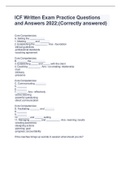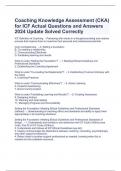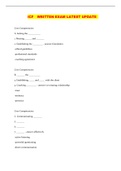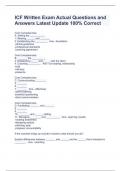ICF Study guides, Class notes & Summaries
Looking for the best study guides, study notes and summaries about ICF? On this page you'll find 1827 study documents about ICF.
All 1.827 results
Sort by
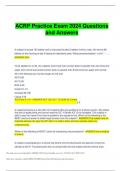 Popular
Popular
-
ACRP Practice Exam 2024 Questions and Answers
- Exam (elaborations) • 15 pages • 2024
-
- $17.99
- 2x sold
- + learn more
ACRP Practice Exam 2024 Questions and Answers A subject is issued 120 tablets and is instructed to take 2 tablets 4 times a day. He returns 88 tablets on the morning of day 9 fasting for laboratory tests. What percentcompliant is he? - ANSWER 50% To be eligible for a trial, the subjects must have liver function tests no greater than two times the upper limit normal and rental function tests no greater than three times the upper limit normal. All of the following are normal ranges fo...
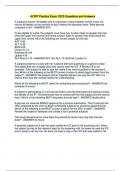 Popular
Popular
-
ACRP Practice Exam 2023 Questions and Answers
- Exam (elaborations) • 8 pages • 2023 Popular
-
- $10.00
- 2x sold
- + learn more
A subject is issued 120 tablets and is instructed to take 2 tablets 4 times a day. He returns 88 tablets on the morning of day 9 fasting for laboratory tests. What percent compliant is he? - ANSWER 50% To be eligible for a trial, the subjects must have liver function tests no greater than two times the upper limit normal and rental function tests no greater than three times the upper limit normal. All of the following are normal ranges for the trial: AST 5-65 ALT 5-35 BUN 4-25 Creat 0.5-1.2...
ICF Written Exam Practice Questions and Answers 2022;(Correctly answered)
Coaching Knowledge Assessment (CKA) for ICF Actual Questions and Answers 2024 Update Solved Correctly
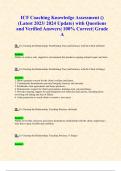
-
Coaching Knowledge Assessment (CKA) for ICF (Latest 2023/ 2024 Updates STUDY BUNDLE WITH COMPLETE SOLUTIONS) Questions and Verified Answers| 100% Correct| Grade A
- Package deal • 4 items • 2024
-
- $23.49
- 1x sold
- + learn more
Coaching Knowledge Assessment (CKA) for ICF (Latest 2023/ 2024 Updates STUDY BUNDLE WITH COMPLETE SOLUTIONS) Questions and Verified Answers| 100% Correct| Grade A
ICF WRITTEN EXAM LATEST UPDATE ...
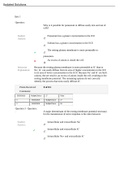
-
NSG 5003 WEEK 1 QUIZ / NSG5003 WEEK 1 QUIZ: ADVANCED PATHOPHYSIOLOGY (LATEST 2022/2023):SOUTH UNIVERSITY
- Exam (elaborations) • 42 pages • 2023
-
Available in package deal
-
- $12.64
- 2x sold
- + learn more
NSG 5003 WEEK 1 QUIZ / NSG5003 WEEK 1 QUIZ: ADVANCED PATHOPHYSIOLOGY (LATEST 2022/2023):SOUTH UNIVERSITY -Why is it possible for potassium to diffuse easily into and out of cells? Potassium has a greater concentration in the ICF. Sodium has a greater concentration in the ECF. The resting plasma membrane is more permeable topotassium. An excess of anions is inside the cell. Instructor Explanation: Because the resting plasma membrane is more permeable to K+ than to Na+, K+ can easily diffuse ...
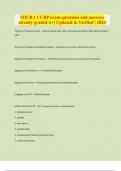
-
SOCRA CCRP exam questions and answers already graded A+| Updated & Verified | 2024
- Exam (elaborations) • 10 pages • 2024
-
- $12.48
- 1x sold
- + learn more
Timeline of Historical Events - Nuremberg Code 1947, Declaration of Helsinki 1964, Belmont Report 1979 The Three Principles of the Belmont Report - respect for persons, beneficence, justice Application of Respect for Persons - informed consent (autonomy, choose for themselves) Application of Beneficence - risk/benefit analysis Application of Justice - appropriate selection of patients (equality) Language Level ICF - 6th-8th grade 8 basic elements of ICF - 1. purpose, duration, and procedu...
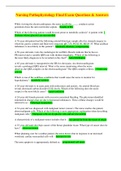
-
Nursing Pathophysiology Final Exam Questions & Answers
- Exam (elaborations) • 19 pages • 2023
-
Available in package deal
-
- $14.64
- 2x sold
- + learn more
Nursing Pathophysiology Final Exam Questions & Answers-While viewing the electrocardiogram, the nurse recalls the _____ conducts action potentials down the atrioventricular septum. - Bundle of His Which of the following patient would be most prone to metabolic acidosis? A patient with: - Diabetes whose glucoses are uncontrolled A 76-year-old patient had the following arterial blood gas sample after his stomach surgery in which his gastric content and fluid were removed: pH 7.55, PCO2 50,...
ICF Written Exam Actual Questions and Answers Latest Update 100% Correct

How did he do that? By selling his study resources on Stuvia. Try it yourself! Discover all about earning on Stuvia

